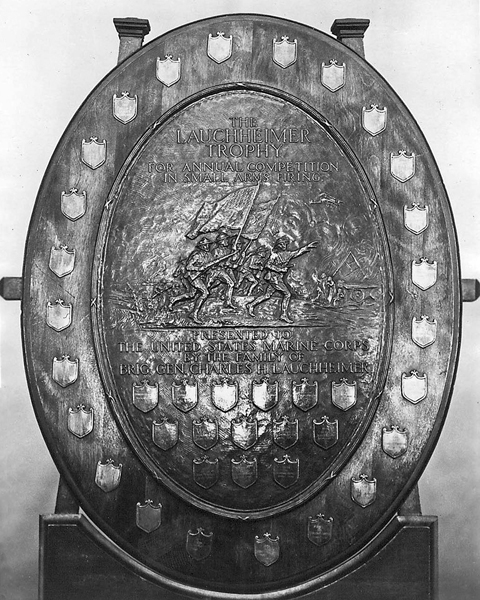
(1921 - 1965)
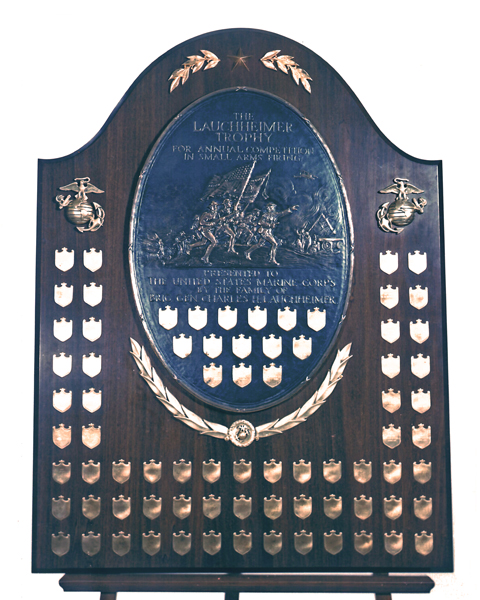
(1966 - Current)
The Lauchheimer Trophy
The Lauchheimer Trophy was presented to the Marine Corps in 1921 by the family of the late Adjutant and Inspector of the Marine Corps, Brigadier General Charles H. Lauchheimer captained the first Marine team to enter rifle competition.
The competitor attaining the highest aggregate score in the individual rifle and pistol competitions at the Marine Corps Matches will be awarded a replica trophy plaque of the Lauchheimer Trophy, a gold badge, and a Certificate of Commendation from the Commandant of the Marine Corps. The name of the winner will be inscribed on the trophy that is displayed at WTBn, Quantico. The competitors receiving the second and third highest score will be awarded a silver and bronze badge respectively.
During the early years (1921 - 1930) the award was made on the basis of 70% for Rifle and 30% for Pistol.
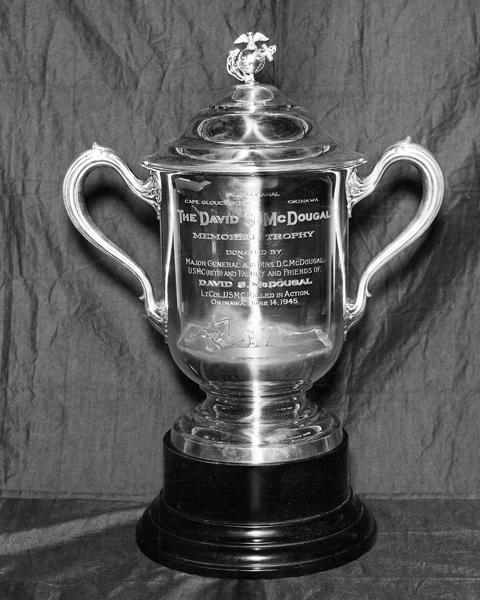
The David S. McDougal Memorial Trophy
Marine Corps Individual Rifle Match
The Marine Corps Rifle Match became a part of the annual competition in 1909. In its early years competitors to the Marine Corps Rifle Match came from team members and marksmen who had successfully competed in the Division Rifle Match at Winthrop, Maryland. The other Division medal winners were not ordered to the Marine Corps Rifle Match. In some years the event was fired after the conclusion of the National Matches. In 1919 the present system of Division medal-winners competing in the Marine Corps Rifle Match was adopted.
The Trophy is named in honor of Lieutenant Colonel David S. McDougal. It was the first awarded in 1947 when Major General Douglas C. McDougal, his father, presented the Trophy to the Marine Corps in behalf of the family and friends of the late Colonel McDougal.
David McDougal at 16 years old, placed third among more than 1,000 competitors in the President's Match. After graduation from the Naval Academy in 1933, he was commissioned in the Marine Corps. Two years later he had Distinguished with both rifle and pistol. Fired with 1935, 1936, 1937 and 1940 Marine Corps teams. In World War II, after fighting throughout the Pacific, McDougal was killed in action on Okinawa in 1945.
The competitor attaining the highest aggregate score in the Marine Corps Individual Rifle Match will be awarded a replica trophy plaque of the David S. McDougal Memorial Trophy and a special gold badge. The name and score of the winner will be engraved on the trophy which, under the conditions of the award, is permanently displayed at WTBn, Quantico.
The Marine Corps Rifle Match winner was awarded a medal, suitable for wearing on the uniform since 1952.
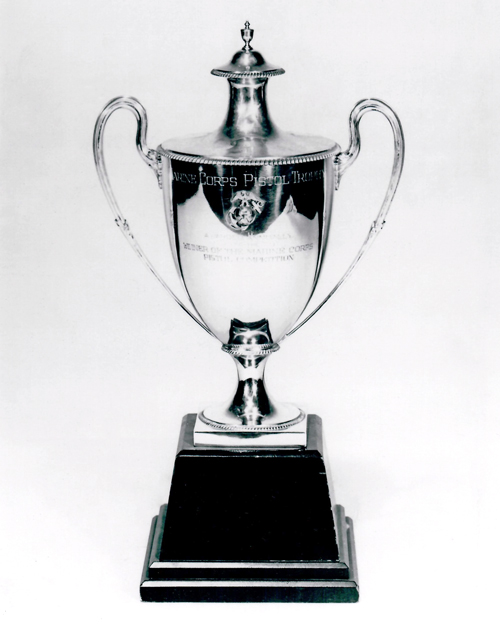
(1921 - 1970)
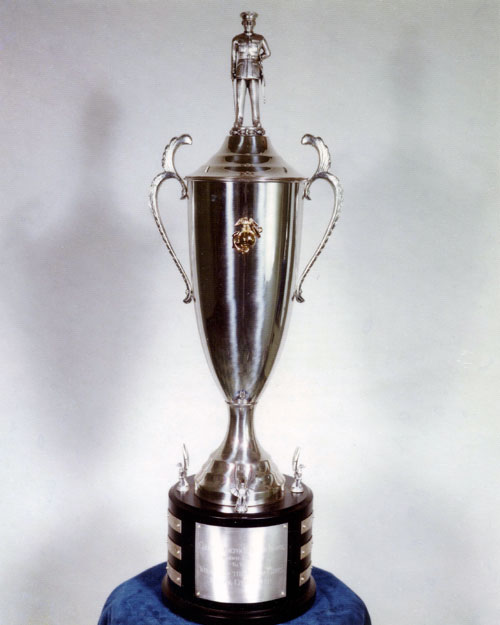
(1971 - 1972)
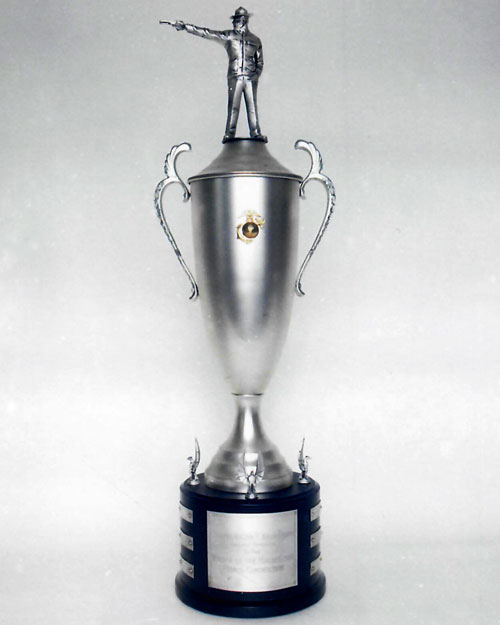
(1973 - Current)
The Walter R. Walsh Trophy
Marine Corps Individual Pistol Match
Unlike the rifle, the pistol did not become part of the Marine Corps Match until 1921. No special recognition was given to the winner until 1947 when the Marine Corps Pistol Trophy was awarded to the winner for his retention until the following year. Starting in 1952 the Marine Corps awarded the victor a gold medal which may be worn on the uniform.
The Walsh Trophy is named in honor and recognition of Colonel Walter R. Walsh, U.S. Marine Corps (retired). Colonel Walsh was the first Marine to become "Triple Distinguished," winning the Distinguished Rifleman Badge, Distinguished Pistol Badge and the International Distinguished Badge for his exploits with the U.S. Teams in International Competition. In addition to his prowess with both the rifle and pistol, Colonel Walsh has contributed more to the Marine Corps Marksmanship Program than any living Marine.
The competitor attaining the highest aggregate score in the Marine Corps Individual Pistol Match will be awarded a replica trophy plaque of the Walter R. Walsh Trophy and a special gold badge. The name and score of the winner will be engraved on the trophy, which under the conditions of the award, is permanently displayed at WTBn, Quantico.
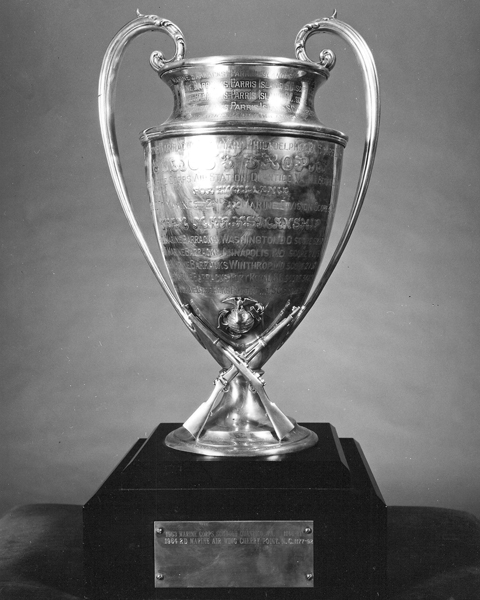
The Elliott Trophy
Eastern Division (Rifle)
First awarded in 1910, the Elliott Trophy is the oldest in Marine Corps competition. Purchased by the officer members of the 1909 and 1910 Marine Corps Rifle Team. At that time the 12 man team match fired for the Trophy included 30 rounds with the rifle at 200 and 300 yards, and 6 rounds slow fire with the service revolver. Ten dollars went to each member of the winning team.
The Trophy bears the name of an early advocate of Marine Corps competitive marksmanship. As early as 1897, George F. Elliott showed interest in rifle shooting, by being instrumental in having a group of Marine officers ordered to Creedmoor to receive instruction from the renowned marksmen of the New York State National Guard. As Major General Commandant from 1903 to 1910, Elliott assisted the development of Marine competitive marksmanship. Not a shooter, he brought the Marine Corps its first rifle range, at Winthrop, Maryland. He also introduced what has become our present day system of Division and Marine Corps Matches. In 1908 Elliott received approval from the Secretary of the Navy for the awarding of Distinguished Marksman badges.
The Match consists of a team from post or separate organization having a quota of 2 or more competitors in Eastern and Southeastern Division Rifle Match. Team consist of a team Captain and 4 shooting members, with at least one officer as a shooting member and one enlisted member who has not competed in any Elliott, San Diego, Wirgman, or Inter Division or Marine Corps National Rifle Team.
The match consists of firing the rifle match course twice, and shall be fired in 2 days. The Trophy is retained by the Commanding Officer of winning post for 1 year, and a gold badge awarded to each firing member of winning team.
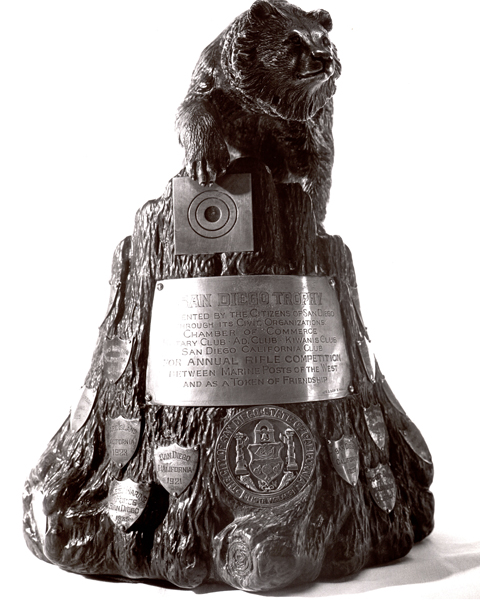
The San Diego Trophy
Western Division (Rifle)
As early as 1912, Marines stationed along the West Coast had annually engaged in interpost rifle team matches. Only a few teams, usually one from Pearl Harbor, San Diego, Mare Island and Bremerton, competed for the $10.00 that would go to each Marine on the winning team. In 1921, several civic organizations joined together to "promote friendship between the citizens of San Diego and the United State Marine Corps" by presenting a trophy. Initially called the San Diego Perpetual Trophy, it was given to the Marine Corps to be used as a prize in the annual interpost rifle competition. The bronze California Bear, atop a redwood base, frequently causes spectators to refer this as the "Bear Trophy." The initial 1921 competition was held on the range at Mare Island, but in 1926 the Trophy Match, as well as the Western Division Matches, was moved to San Diego. Since 1955, only major West Coast posts compete for the San Diego Trophy.
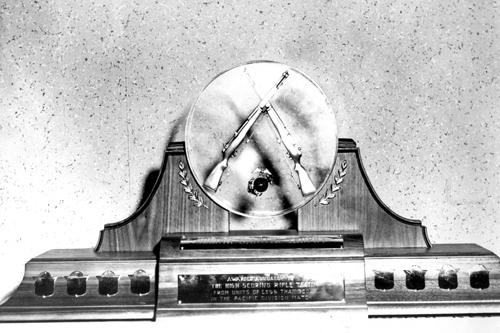
The Smith Trophy
Pacific Division (Rifle)
This Pacific Division Rifle Team match honors Lieutenant General Julian C. Smith. In Smith's early years in the Corps, he captained several small unit teams and teams from ship detachments. In 1921, he fired in the Eastern Division Matches, winning a bronze pistol medal.
It was in 1928 as captain of the Marine Corps Team, he took an unknown squad to Wakefield and on to Camp Perry. Little was expected of the team as so many of the old shooters were on expeditionary duty. The team took four events of the National Board, the rifle team and individual matches and the same events with the pistol. Although not as successful he also captained the 1929 team.
General Smith commanded the Second Marine Division in assaulting Tarawa.
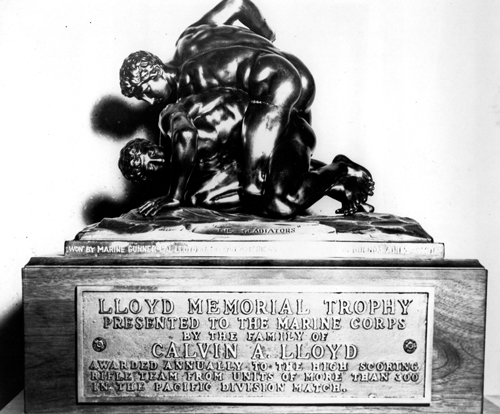
The Lloyd Trophy
Far-Eastern Division (Rifle)
Few Marine Marksmen have been held in such high esteem as Chief Marine Gunner Calvin A. Lloyd. In 1908 after failing to qualify, he set to work to learn rifle marksmanship. In 1911 he Distinguished by placing the Division and Marine Corps Match and fired on the first Marine Corps team to win the National Trophy.
In 1912 on the American team at Buenos Aires in the Pan American games, he won a beautiful statue which is now the Lloyd Trophy. In 1921, he set a world's record at Sea Grit, by firing 101 consecutive bulls at a 16 inch bullseye at 600 yards. The falling darkness halted this performance. No Marine fired or coached more teams in the National Trophy Rifle Team Match than Calvin Lloyd.
Gunner Lloyd died in 1943. His widow donated his 1912 prize to the Marine Corps in 1956. In 1957 the Lloyd Trophy became part of the Pacific Division Matches.
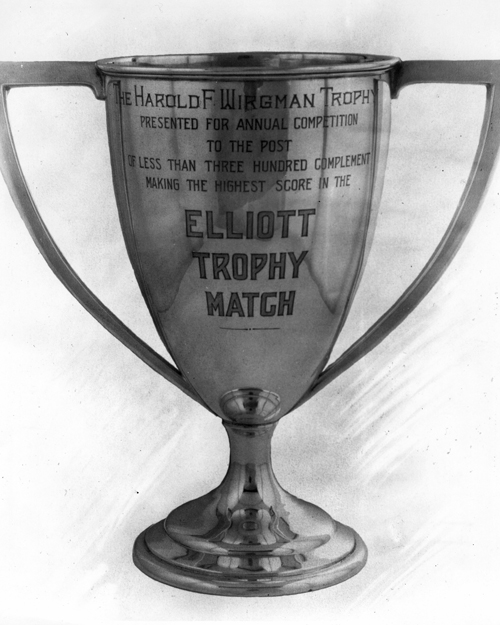
The Wirgman Trophy
Eastern Division (Small Unit Rifle)
The poor standing of small post and stations competing for the Elliott Trophy, prompted Lieutenant Colonel Harold F. Wirgman to present to the Marine Corps the trophy that bears his name. Wirgman long associated with Marine Corps Marksmanship, mainly in organizing teams and promoting shooting. During the period following World War I, Wirgman handled the team arrangements at Wakefield and Camp Perry.
The Trophy was placed in competition in 1926 for east coast units with complements under 300. Today the strength of post must be less than 60.
The Match consists of a team from post competing in Eastern and Southeastern Division Rifle Match. Team consist of 4 shooting members, with at least one officer as a shooting member, and at least 1 enlisted member who has not competed in any Elliott, San Diego, Wirgman, or Inter-Division or Marine Corps National Rifle Team.
The Match consists of firing the rifle course twice, and shall be fired in 2 days. The Trophy is retained by the Commanding Officer of winning post for 1 year, and a gold badge awarded to each firing member of winning team.
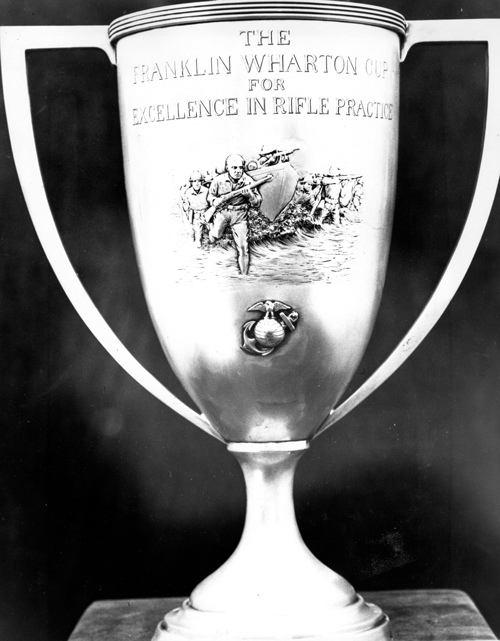
The Wharton Trophy
Western Division (Small Unit Rifle)
The Wharton Trophy is the second oldest associated with Marine marksmanship. It was presented in 1918 by Mrs. Sara Wharton Howard, great granddaughter of Lieutenant Colonel Franklin Wharton, an early Marine Corps Commandant. Until World War II it was awarded annually to the company having the best qualification record with all small arms weapons.
In 1955 the Wharton Trophy was revived and awarded on the same bases as the Wirgman Trophy, except to west coast units firing in Western Division Matches.
Team consist of 4 shooting members with at least one officer as a shooting member, and at least 1 enlisted member who has not competed in any Elliott, San Diego, Wirgman, or Inter Division or Marine Corps National Rifle Team.
The Match consists of firing the rifle course twice, and shall be fired in 2 days. The trophy is retained by the Commanding Officer of winning post for 1 year, and gold badge awarded to each firing member of winning team.
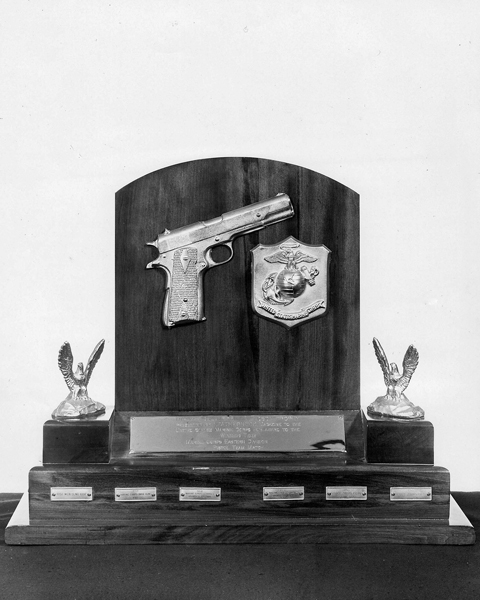
The Edson Trophy
Eastern Division (Pistol)
This Pistol Team Match is fired between posts and stations participating in the Eastern Division Matches. Named in honor of Merritt A. Edson, a Marine officer closely associated with competitive shooting during the 1920's and 1930's. Commissioned in 1917, Distinguished with the rifle in 1927, a firing member of the winning 1921 Marine Corps National Trophy Rifle Team.
"Red Mike" Edson coached and captained several Marine Corps teams during the 1930's. Prior to WWII, he was Inspector of Target Practice. In 1942 on Guadalcanal, as Commanding Officer of the First Raider Regiment, Edson received the Congressional Medal of Honor. At the time of his death in 1955, the retired Major General was Executive Director of the National Rifle Association.
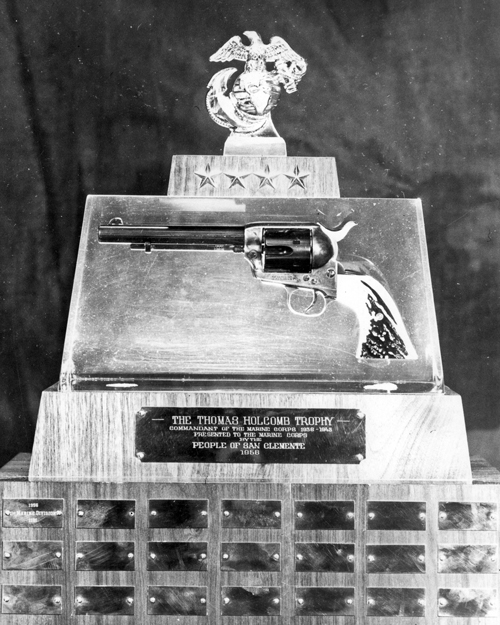
The Holcomb Trophy
Western Division (Pistol)
This pistol Team Match is fired between posts and stations participating in the Western Division Pistol Matches. Inaugurated in 1956, in honor of the 17th Commandant of the Marine Corps. In 1901, as a second lieutenant, he was a member of the first Marine Corps competitive rifle team which went to Sea Grit, New Jersey to compete for the Hilton Trophy. The 1902 match between the United States, Canada and Great Britain found the American team finished second. Holcomb was the sole military competitor, and youngest member of the team, came up with the high score. Holcomb Distinguished with the rifle in 1908. In 1911 he was a member of the first Marine Corps rifle team to win the National Trophy. He was Inspector of Target Practice from 1914 to 1917, and as Commandant, the Marine Corps had some of the strongest team in National competition.
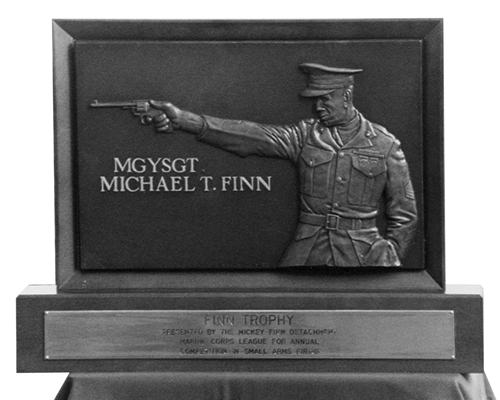
The Finn Trophy
Pacific Division (Pistol)
Established in 1986, this Pistol Trophy Match is fired in the Pacific Division Matches. Named in honor of Master Gunnery Sergeant Michael T. Finn, affectionately known as "Mickey." Enlisting in 1915, Finn played his part in World War I. In June 1918, he was in the Battle of Belleau Wood and, as a Gunnery Sergeant, was awarded the Silver Star.
Finn was always interested in hunting and enjoyed shooting. Master Gunnery Sergeant Finn was double distinguished, first with the pistol in 1922, and with the rifle in 1930. Master Gunnery Sergeant Finn was the first Marine promoted to the rank of Master Gunnery Sergeant with the precedence of number 1.
Master Gunnery Sergeant Finn retired on 9 November 1946. The Finn Trophy was presented to the Marine Corps by the members of the Mickey Finn Detachment Marine Corps League, Trinagle, Virginia.
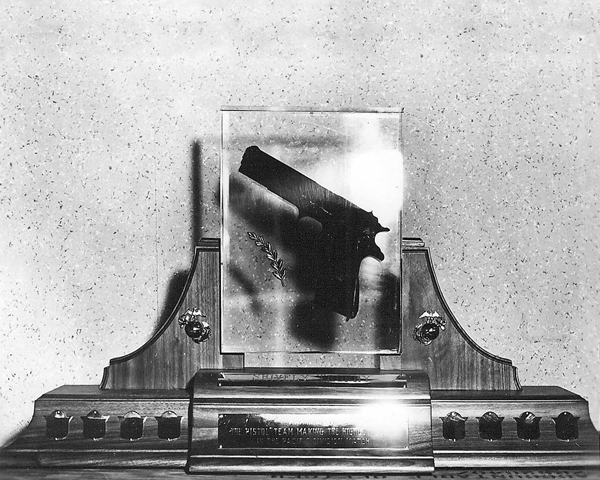
The Shively Trophy
Far-Eastern Division (Pistol)
This Pistol Team Match competed for in the Pacific Division Matches. The Trophy is named honor of Colonel Morris L. Shivley, who started competitive shooting in the 1920's. Shively Distinguished with the rifle in 1924, and during the 1930's he was captain of several Marine Corps teams.
While at Basic School in Philadelphia from 1936 to 1938, Colonel Shively was instrumental bringing several new Officers into the shooting game. Also, he assisted in developing a modified caliber. .45 barrel that now bears his name. The Shively barrel had an extended tang and was built up at the muzzle. This served to hold the barrel in slide more rigid, this increasing accuracy of the Cal. 45 Pistol.
The Trophy is awarded to the high four man pistol team competing in the Pacific Division Match.
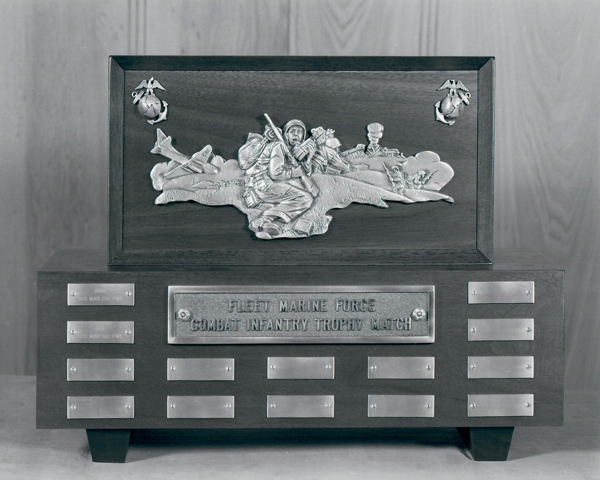
The FMF Combat Infantry Trophy
The Fleet Marine Force Combat Infantry Trophy is awarded to the winning team of the Fleet Marine Force Combat Infantry Trophy Match. The match is based on the Infantry Trophy Team match, which has been fired in the National Matches since before World War II and was fired in the Marine Corps Matches from 1960 to 1967. The team consists of six shooting members, a team captain and a team coach that simulate a rifle squad employing rapid fire in the combat situation.
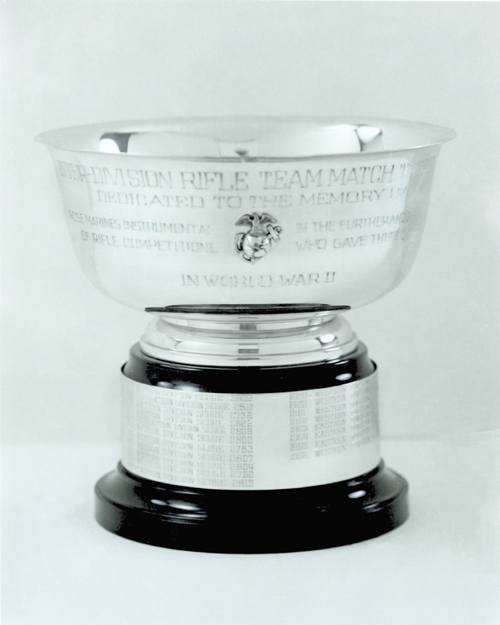
The Inter-Division Rifle Team Trophy
The Inter-Division Rifle Team Match Trophy is awarded to the winning team of the Marine Corps Inter-Division Rifle Team Match. The Trophy is dedicated in memory of those Marines instrumental in the furtherance of rifle matches, who gave their lives in World War II.
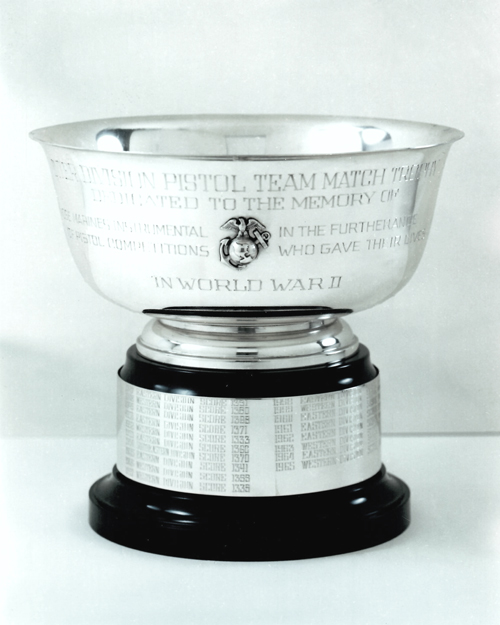
The Inter-Division Pistol Team Trophy
The Inter-Division Pistol Team Match Trophy is awarded to the winning team of the Marine Corps Inter-Division Pistol Team Match. The Trophy is dedicated in memory of those Marines instrumental in the furtherance of pistol matches, who gave their lives in World War II